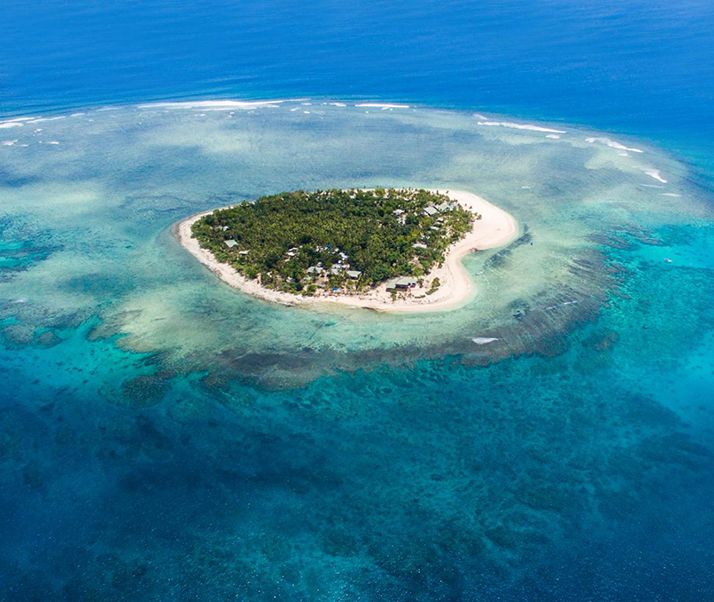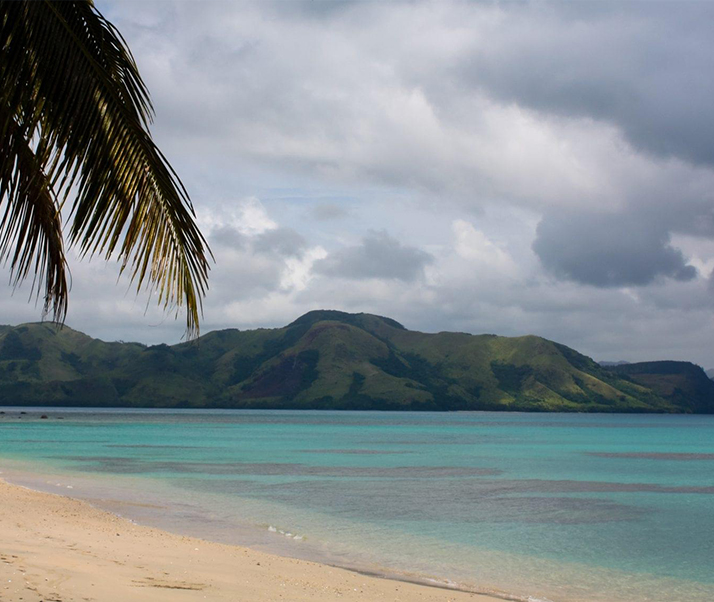+91 9884683139
talk to our Destination
specialist

If you think about Fiji and picture an island oasis, you’d be spot on. Picture hammocks swaying in the breeze between two coconut trees, friendly, vibrant local culture and people, interesting villages and wild jungle that ends where bright beach begins.
Fiji is set in the middle of the South Pacific Ocean, less than 4 hours flight east of Brisbane and Sydney. It is made up of more than 330 islands and is surrounded by Vanuatu and New Caledonia to the west, Samoa and Tonga to the east and New Zealand to the south. Each of Fiji’s islands boast an incredible landscape.
Lush tropical and pine vegetation is spread across the interior lands and white sandy beaches wrap around the coasts. Pristine blue-green waters house vibrant soft coral reefs and there are deep drop-offs, perfect for diving and fishing. Only just over 100 of the nation’s islands are permanently inhabited Its major islands of Viti Levu and Vanua Levu hold most of the country’s populace of nearly 900,000 people.
Fiji’s northern island boasts some of the world’s most well-preserved rainforests. Islands such as Vanua Levu, Qamea, Taveuni, and Laucala hold over 164 species of wildlife, many of which can only be found in Fiji.
Key Facts
9,26,795
Suva
Fiji Dollar
Fijian,Hindi,English
GMT +12
May -Oct

Fiji’s calm seas belie the riot of life going on within. With seemingly endless stretches of intensely coloured reefs and more than 1500 species of fish and colossal creatures Fiji’s underwater world is worth the plunge.
Seasoned divers and snorkellers will find plenty to excite them, while first-timers will be bubbling excited exclamations into their mouthpieces.
Anywhere a fin flashes or coral waves, you’ll find a diving or snorkel day trip and there are excellent live-aboard journeys for those after a truly immersive experience.
Fijian lifestyle is a relaxed combination of traditional culture and a strong belief in the family and community. Fijians live a slow-paced lifestyle, visitors from the busy western world can sometimes feel annoyed at what the locals endearingly refer to as “Fiji time”. Fiji time is the notion of things getting done eventually or not at all, without any stress of time.
Fiji’s arts and crafts are a replication of the country’s Polynesian and Melanesian heritage. Fiji is a culture renowned for its arts and craft and is the biggest selling souvenirs for visitors.
The Fijian cuisine, is an homage to the sea and its treasures. Most dishes employ the use of the tropical coconut, which renders its unique flavour and mood to the food.
Fijians are famous for their hospitality and warmth, which makes it easy to make friends or immerse yourself in Fijian culture.
Lapping up against the pristine glistening sands of its endless coast, the South Pacific carries with it the familiar whiff of the majestic ocean, the haunting cooing of the sea-gulls ready for their repose and the dull clamour of the waves kowtowing to moist mother Earth, in divine surrender. Amidst these raw aesthetics and the languid stretches of the shore, discover Fiji.

The Heartbeat of the Pacific
Bula and welcome to Fiji!’s capital and largest city! Everyone passes through Viti Levu, Fiji's largest island, on their trip to Fiji. , but too often it's looked at as just home to an international airport, an unavoidable transit stop for those en route to a palm-fringed resort. But those who skip the island too
quickly are missing out, as there are plenty of attractions to make you linger longer.
Away from the gateway hub of Nadi, the southern Coral Coast offers a lively mix of resorts aimed at families and backpackers alike, and a host of adventure sports including scuba diving with massive tiger sharks.
While sultry Suva, the South Pacific's largest city, has a rich cultural heritage to explore, northern Viti Levu's best attractions are on the water, from the dolphin-spotting and kite-surfer paradise of Nananu-i-Ra, to the coral reefs of the Bligh Passage. Tie this in with visits to traditional villages and breathtaking waterfalls, and you will find that Viti Levu is easily the centrepiece of any Fijian trip.

The Coastal Paradise
Extending in an arc off the coast of Viti Levu, the Mamanucas and Yasawa Islands are a chain of beautiful palm-fringed islands with perfect white sandy beaches, placid lagoons and picturesque resorts. This is Fiji’s tourism gem, attracting thousands of visitors from all over the World.
Thankfully, though, the islands remain remarkably undeveloped – no building rises higher than a coconut palm and even on the most popular islands it’s possible to wander a short distance to find a secluded stretch of beach. The focus here is on relaxation. Most visitors spend their days sunbathing, snorkelling or scuba diving, with sightseeing limited to hiking between small villages or trekking to a hilltop to see the sunset.
Evenings are spent around the resort bar and restaurant which, apart from at a couple of backpacker resorts, tend to wind down around 10pm – this is no Bali or Ibiza, though there are plenty of opportunities to try yaqona (kava).
While the Mamanucas got Tom Hanks’s Cast Away shot there, the Yasawas got Brooke Shields when the 1980 film Blue Lagoon was filmed here.

A Slice of True Island Life
Next to the orderly, landscaped gardens of Fiji’s traditional tourist beat, Kadavu’s vine-tangled jungles, rocky headlands and isolated beaches feels wild and raw. The Great Astrolabe Reef - one of the largest barrier reefs in the world – hugs Kadavu’s southern border reaching up east to wrap around Ono
and a cluster of other small islands in the archipelago.
It’s heaven for snorkellers, divers and deep-sea fishermen; a watery Eden where you can swim alongside majestic manta rays, dive colourful coral gardens or explore remote bays on ocean-going kayaks.
Anywhere you stay, you'll have to get there by boat from the main village passing by prehistoric-looking jungle coves chirping with rare and colorful endemic birds.
If you love the outdoors and seek out blissful isolation, then Kadavu might be place for you.

The Sandal Wood Island
Though it’s Fiji’s second-largest island, Vanua Levu (Big Island) is one of the tropics’ best-kept secrets. It’s another world from the bustle of Viti Levu and the more-touristed islands: many roads are little more than rutted dirt tracks, and Labasa, the island’s largest ‘city’, is a one-street strip of shops.
To the south, Savusavu entices yachties, divers and dreamers looking for a tropical idyll. The rest of ‘Big Island’ is given over to sugarcane and copra plantations, hideaway villages, mountain passes streaming with waterfalls, endless swaths of forest and an ever-changing coastline forgotten by the world. Take it slow, keep a smile on your face and savour rural Fiji on its grandest scale.

The Garden Island of Fiji
Taveuni is covered with lush rainforest, brimming with colorful flora and fauna, much of which is extremely rare and endemic to the Fijian archipelago. The Bouma National Heritage Park protects approximately 80% of Taveuni’s land, sheltering a series of picturesque waterfalls,
rivers, creeks, and canyons, which offer numerous opportunities to swim, climb, and hike in the island’s awe-inspiring surroundings.
A highlight is the Lavena Coastal Walk that follows the forest's edge for five kilometers along white and black sand beaches and villages to a lush waterfall.
The Rainbow Reef (see Vanua Levu above) is also accessed from Taveuni and smaller offshore islands like Qamea and Matagi hold resorts on stunning remote white sand beaches.
Taveuni is known as “the garden island of Fiji” because of its abundant plant life, which includes several species found only on the island.